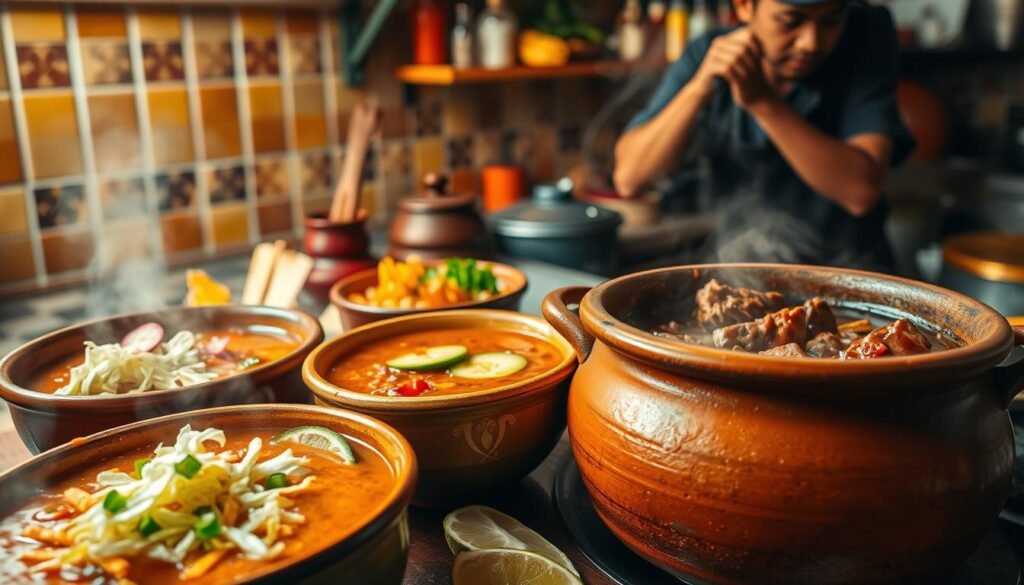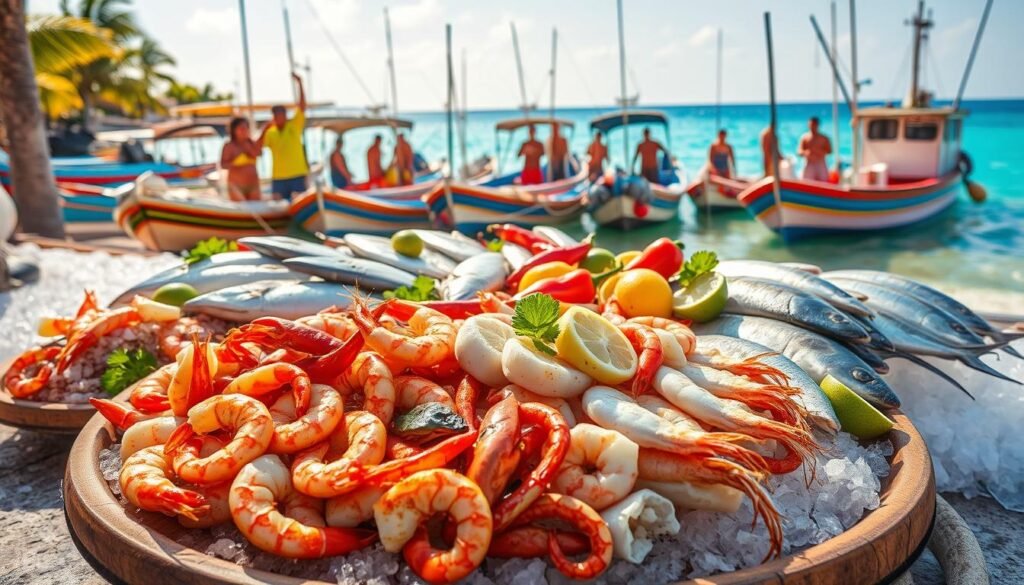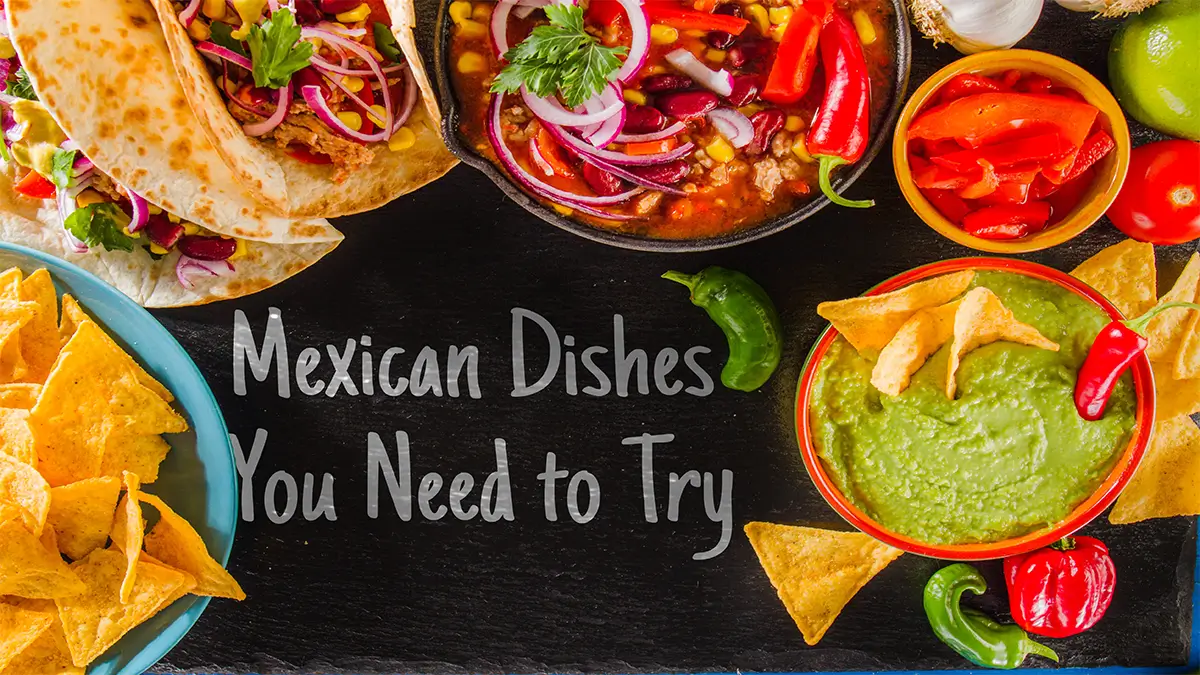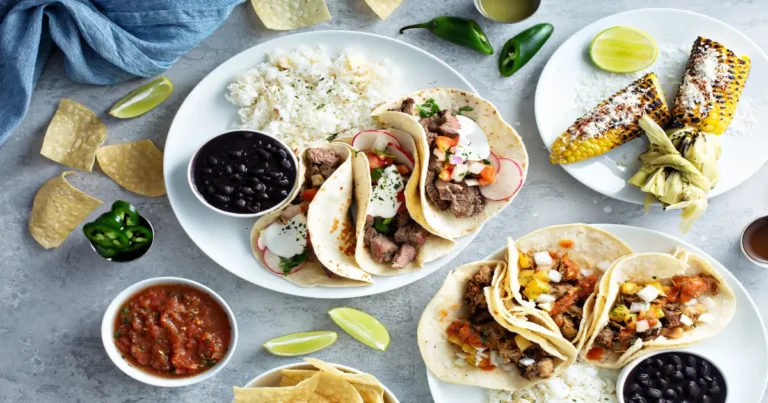Mexican Dishes You Need to Try at Least Once in Your Life
Did you know that Mexican cuisine is incredibly diverse and vibrant? It boasts over 200 different traditional meals. From the spicy kick of salsa roja to the comforting warmth of a well-made tortilla, these best Mexican dishes show the country’s complex history and cultural identity.
Exploring the world of Mexican meals is a flavorful journey. You’ll find a rich heritage and diverse regional specialties. These have something for every palate. In this article, we’ll look at the must-try delicacies that will make you appreciate this vibrant cuisine more.
The Rich Heritage of Mexican Cuisine
Exploring Mexican cuisine is like a journey through the country’s past. Each dish tells a part of its heritage. It shows the country’s complex history and cultural identity.
UNESCO’s Recognition of Mexican Culinary Traditions
In 2010, UNESCO named Mexican cuisine as an Intangible Cultural Heritage of Humanity. This shows its importance as a symbol of cultural identity. It highlights the need to keep traditional cooking methods and ingredients alive.
Pre-Hispanic Influences on Modern Mexican Food
The roots of Mexican cuisine go back to the pre-Hispanic era. Indigenous communities introduced staples like corn, beans, and chili peppers. These ingredients are key in modern Mexican cooking, mixing with European and African influences.
As you explore traditional Mexican food, you’ll see the heritage in every bite. The heritage of Mexican cuisine is essential to understanding its diverse dishes. From mole sauces to simple tortillas, each part adds to the rich authentic Mexican cuisine.
Authentic Mexican Dishes vs. Tex-Mex
Exploring Mexican cuisine reveals a big difference between real dishes and Tex-Mex. Tex-Mex is popular, but knowing the gap between it and true Mexican cooking makes meals more enjoyable.
Key Differences in Ingredients and Preparation
Ingredients are a big difference. Real Mexican dishes use corn, beans, chilies, and squash. Tex-Mex, on the other hand, often has ground beef, cheese, and canned items. Cooking methods also differ, with traditional Mexican food focusing on detailed techniques and presentation.
- Use of native ingredients like chilies and masa harina
- Complex cooking techniques, such as slow-cooking and grilling
- Emphasis on regional specialties and traditional recipes
Regional Authenticity in Mexican Cooking
Mexican food is very diverse, with each area having its own special dishes and tastes. The Yucatán’s cochinita pibil and Oaxaca’s mole negro are just a few examples. Knowing these regional differences helps you see the depth of Mexican cuisine.
By trying authentic Mexican recipes and learning about their cultural background, you can have a richer and tastier food experience.
Essential Mexican Dishes That Define the Cuisine
Mexican cuisine is a mix of many flavors. Some dishes are must-try experiences. These iconic dishes are key to understanding Mexican food.
Tacos al Pastor: The Iconic Street Dish of Mexico
Tacos al pastor is a famous Mexican street food. It features marinated pork cooked on a vertical spit. The pork is served with pineapple, onions, and cilantro in a warm tortilla.
This dish shows Mexico’s culinary complexity. The mix of flavors and textures is a tribute to Mexico’s rich culture.
Enchiladas: The Versatile Classic
Enchiladas are a staple in Mexican cuisine. They are known for their versatility and rich flavors. These corn tortillas are filled with meat, cheese, or vegetables.
They are covered in a savory sauce and melted cheese. You can find enchiladas in different regions of Mexico. Each region has its own twist, making them a dish worth trying.
Chiles Rellenos: A Study in Contrasts
Chiles rellenos, or stuffed peppers, offer a delightful contrast. Roasted poblano peppers are filled with cheese, meat, or vegetables. They are coated with an egg batter and then fried.
This dish shows the creativity and skill in Mexican cooking. It balances the heat of the peppers with the richness of the filling.
These popular Mexican dishes show the country’s culinary diversity. They highlight the importance of traditional cooking methods and ingredients. When you try these dishes, you’ll experience the bold flavors and rich cultural heritage of Mexican cuisine.
Must-Try Mexican Breakfast Dishes
Starting your day with a traditional Mexican breakfast is unforgettable. These dishes show off Mexico’s rich food culture. They offer a mix of comforting, elaborate, and flavorful options.
Chilaquiles: The Ultimate Comfort Food
Chilaquiles is a favorite breakfast made from fried tortilla chips. They’re smothered in salsa, cheese, and sometimes topped with crema or sour cream. This dish is a hearty start to the day in Mexican cuisine.
Huevos Rancheros: Farm-Fresh Flavors
Huevos rancheros is a classic Mexican breakfast. It has fried eggs on tortillas, topped with spicy tomato sauce and melted cheese. This dish highlights Mexico’s farm-fresh flavors, making it a must-try.
Conchas and Mexican Coffee: The Perfect Pairing
No Mexican breakfast is complete without concha pastry and Mexican coffee. Conchas have a colorful sugar topping and a soft, fluffy interior. They pair perfectly with the bold flavors of Mexican coffee, creating a delightful breakfast.
These Mexican breakfast dishes satisfy your morning cravings and offer a taste of Mexico’s rich culinary traditions. Whether you’re in Mexico or trying them elsewhere, they’re sure to impress.
Iconic Mexican Street Food Experiences
Start a food journey through Mexico’s street food world. It’s full of flavors and textures. You’ll find these tasty dishes at markets, street stalls, and local spots all over Mexico.
Elote and Esquites: Mexican Street Corn Two Ways
Don’t miss out on elote and esquites, two favorite street corn dishes. Elote is grilled corn on the cob with mayonnaise, chili powder, and lime juice. It’s a great summer snack. Esquites, or Mexican popcorn, is made from fresh corn kernels. It’s served in a cup with lime juice, chili powder, and mayonnaise.
Tamales: Portable Perfection
Tamales are a big deal in Mexican street food. They’re steamed corn dough pockets filled with meat, cheese, or veggies. Wrapped in corn husks, they’re perfect for a quick breakfast or snack. Enjoy them with spicy salsa or sour cream.
Tlayudas: Oaxaca’s “Mexican Pizza”
For something special, try tlayudas. They’re large, crispy tortillas with beans, cheese, and meats. From Oaxaca, they’re like a “Mexican pizza.” You can add your favorite toppings for a tasty street food treat.
Exploring Mexican street food is more than just eating. It’s diving into the culture and traditions of Mexico. Each dish has its own story and offers a glimpse into the country’s rich food heritage.
Savory Mexican Soups and Stews
Exploring Mexican cuisine reveals a world of savory soups and stews. These dishes are comforting and flavorful. They reflect the country’s rich culinary heritage and are key in celebrations and daily meals.
Mexican soups and stews vary greatly, with each region having its own special versions. Let’s look at some of the most iconic ones.
Pozole: The Celebratory Soup
Pozole is a hearty soup with hominy and pork or chicken. It’s topped with lime wedges, shredded cabbage, and radishes. This soup is a big deal on holidays and family gatherings. Its rich flavors and warmth make it a cherished tradition.
Menudo: The Traditional Hangover Cure
Menudo is a spicy soup with tripe (cow’s stomach lining) in a chili pepper and spice broth. It’s famous for curing hangovers in Mexico. The tender tripe and spicy broth make it a unique and tasty experience.
Caldo de Camarón: Coastal Comfort
Caldo de Camarón, or shrimp soup, comes from Mexico’s coastal areas. It’s made with fresh shrimp, veggies, and sometimes coconut milk. This soup is a delicious way to taste the sea’s fresh flavors.

These soups and stews show off Mexican cuisine’s diversity. They highlight the value of traditional cooking and ingredients. Whether it’s pozole at a family event or caldo de camarón by the coast, Mexican soups and stews are unforgettable.
Regional Mexican Dishes Worth Traveling For
Exploring Mexico reveals a wide range of dishes worth traveling for. The country’s food scene mirrors its varied landscapes, with each area boasting its own flavors and dishes.
Mexico’s food is a testament to its rich culture, with dishes passed down through generations. Let’s dive into some of these regional gems.
Cochinita Pibil: Yucatán’s Slow-Roasted Treasure
Cochinita Pibil is a traditional dish from Yucatán. It’s pork marinated and slow-roasted in a pit oven until it’s tender and full of flavor. It’s often served with rice, beans, and tortillas.
Chiles en Nogada: The Patriotic Dish
Chiles en Nogada is a dish from Puebla, celebrated on Mexico’s Independence Day. It’s poblano chilies stuffed with meats, fruits, and spices. It’s topped with walnut sauce and pomegranate seeds.
Cabrito: Northern Mexico’s Goat Specialty
In Northern Mexico, Cabrito is a favorite. It’s slow-cooked goat meat, served with tortillas, salsa, and refried beans. The tender meat and rich flavors are loved by all.
These dishes are just a glimpse into Mexico’s diverse food scene. As you travel, be sure to try these and other local dishes. They showcase the full richness of Mexican cuisine.
The Complex World of Mole Sauces
Exploring Mexican cuisine means diving into mole sauces. These sauces are rich in history and flavor. They are a key part of Mexican cooking, blending spices, chilies, and chocolate.
These sauces are more than just condiments. They turn a simple dish into something special.
Mole Poblano: A Chocolate and Chili Fusion
Mole poblano comes from Puebla and is famous worldwide. It mixes chocolate with chili heat. This sauce is perfect over chicken or turkey, making the dish both cozy and fancy.
Mole Negro: Oaxaca’s Dark Gold
Mole negro is from Oaxaca and is loved for its dark, rich taste. It’s made with chilies, spices, and sometimes chocolate. This sauce is a deep, complex flavor that shows Oaxaca’s rich food history. It’s often enjoyed on big occasions.
Seven Moles of Oaxaca: A Rainbow of Flavors
Oaxaca is famous for its seven traditional moles. Each mole has its own taste, from nutty to spicy. These sauces show Oaxaca’s diverse food culture. Trying these moles is like traveling through Oaxaca’s food and culture.
Seafood Dishes from Mexico’s Coastlines
Mexico’s coastlines, from the Pacific to the Gulf, are famous for their fresh seafood. The country’s long coastlines bring together a variety of seafood dishes. These dishes show off Mexico’s rich culture and diverse geography.

Ceviche: The Citrus-Cured Delight
Ceviche is a fresh seafood dish made with raw fish and citrus juices. It’s mixed with onions, peppers, and cilantro. This citrus-cured delight is loved worldwide for its simplicity and freshness.
Pescado a la Veracruzana: Spanish-Influenced Coastal Cuisine
Pescado a la Veracruzana comes from Veracruz and shows the region’s cultural mix. It’s a fish dish cooked in a tomato sauce with olives, capers, and spices. This dish blends indigenous and Spanish flavors beautifully.
Aguachile: Sinaloa’s Spicy Seafood Specialty
Aguachile is a spicy seafood dish from Sinaloa. It’s made with raw shrimp in a chili pepper and lime juice mix. This spicy seafood specialty is bold and served with tortillas or tostadas. It’s perfect for those who like spicy food.
These seafood dishes from Mexico’s coastlines show the country’s culinary diversity. They blend different cultures into unique and tasty meals. Trying ceviche, pescado a la veracruzana, or aguachile lets you taste a part of Mexico’s rich food heritage.
Vegetarian Mexican Dishes That Impress
Exploring Mexican cuisine reveals a world of vegetarian dishes that will wow you. Mexican food is more than just meat. It’s filled with tasty, authentic vegetarian options that show off the country’s diverse flavors.
Chiles Rellenos de Queso: Cheese-Stuffed Peppers
Chiles Rellenos de Queso is a standout dish. It’s about stuffing roasted poblano peppers with melted cheese. Then, they’re coated in an egg batter and fried. This dish is a mix of textures and tastes that’s hard to beat.
Enfrijoladas: Bean-Based Comfort Food
Enfrijoladas is another comforting dish. It’s made with tortillas covered in a rich bean sauce. It’s topped with cheese, crema, and fresh herbs. This bean-based dish is both filling and flavorful, a true Mexican staple.
Nopales: Cactus Paddles in Mexican Cuisine
Nopales, or cactus paddles, are a unique ingredient in Mexican cooking. They’re used in salads, soups, or as a side dish. Nopales add a tender, slightly tart flavor, showing the creativity of Mexican cuisine.
These vegetarian Mexican dishes are a fantastic way to explore the rich variety of Mexican cuisine. Whether you’re a vegetarian or just looking to try something new, these dishes will impress with their unique flavors and textures.
Essential Ingredients in Authentic Mexican Dishes
To truly experience Mexican cuisine, it’s essential to understand the ingredients that make it authentic. The richness and diversity of Mexican dishes are largely due to the use of traditional and unique ingredients.
Masa Harina: The Foundation of Mexican Cuisine
Masa harina, a type of corn flour, is the base for tortillas and many other traditional Mexican dishes. It’s made from dried and ground corn kernels that have been treated with lime, a process known as nixtamalization. This process not only makes the corn more easily grindable but also increases its nutritional value.
Mexican Cheeses: From Cotija to Quesillo
Mexican cuisine boasts a variety of cheeses, each with its unique flavor and texture. Cotija cheese, named after the town of Cotija in Michoacán, is a popular choice for its crumbly texture and salty flavor. Quesillo, also known as Oaxaca cheese, is a stringy, mozzarella-like cheese perfect for melting.
The Chile Pepper Spectrum: Pasilla, Serrano, and Beyond
The chile pepper spectrum is vast in Mexican cuisine, ranging from mild to extremely spicy. Pasilla peppers are mild and slightly sweet, often used in sauces and moles. Serrano chilies, on the other hand, are hot and commonly used in salsas and as a topping.
Some key ingredients to keep in mind when cooking Mexican dishes include:
- Masa harina for tortillas and tamales
- Cotija cheese for adding a salty flavor
- Pasilla peppers for a mild, slightly sweet heat
- Serrano chilies for an intense, spicy kick
- Quesillo for melting and adding creaminess
Conclusion: Embracing the Flavors of Mexico
Exploring Mexican cuisine has shown you the rich diversity and cultural depth of this food. You’ve learned about the spicy kick of salsa roja and the comforting warmth of a well-made tortilla. mexican dishes truly reflect Mexico’s history and identity.
Whether you’re a food lover or just starting out, there’s always something new to try. The authentic mexican cuisine dishes you’ve discovered are just the start of your culinary adventure.
Now, it’s time to start cooking and experience Mexico’s rich culinary heritage. Try new recipes, experiment with different ingredients, and explore Mexico’s many regional specialties.
By embracing Mexico’s flavors, you’ll delight your taste buds with bold flavors and textures. You’ll also connect with Mexico’s rich cultural heritage.
FAQ
What is the national dish of Mexico?
Mexico doesn’t have just one national dish. But, dishes like tacos al pastor, enchiladas, and chiles rellenos are very popular. They show how diverse Mexican food can be.
What is the difference between Tex-Mex and authentic Mexican cuisine?
Tex-Mex combines Mexican and American flavors. It often has ground beef and melted cheese. Real Mexican food, on the other hand, sticks to traditional recipes. It uses a wide range of ingredients, including meats, produce, and chilies.
What is masa harina, and how is it used in Mexican cooking?
Masa harina is corn flour made from dried and ground corn. It’s used to make tortillas, tamales, and more. It adds a rich corn flavor and a tender texture to dishes.
What are some popular types of Mexican cheese?
In Mexico, people love cheeses like Cotija, Quesillo, and Oaxaca. Cotija is great as a topping. Quesillo melts well, perfect for chiles rellenos.
What is the significance of chile peppers in Mexican cuisine?
Chile peppers are key in Mexican cooking. They add depth, heat, and complexity to many dishes. From mild pasilla peppers to spicy serrano chilies, there’s a wide variety to choose from.
Can you recommend some vegetarian Mexican dishes?
For vegetarians, try chiles rellenos de queso, enfrijoladas, or dishes with nopales. These options show the variety and richness of Mexican food, even without meat.
What is the difference between salsa roja and other types of salsa?
Salsa roja is a red sauce made with tomatoes, onions, and chilies. Other salsas, like salsa verde or salsa de cacahuate, have different ingredients and tastes. They all add spice and flavor to Mexican dishes.
How is Mexican street food different from restaurant food?
Mexican street food is casual and quick, with vendors serving tacos, elote, and tamales. Restaurant food is often more formal, with a focus on presentation.


